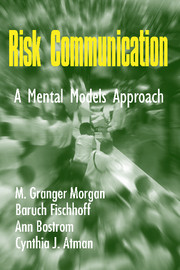Book contents
- Frontmatter
- Contents
- Preface
- Risk Communication
- 1 INTRODUCTION
- 2 OUR MENTAL MODELS APPROACH
- 3 CREATING AN EXPERT MODEL OF THE RISK
- 4 MENTAL MODELS INTERVIEWS
- 5 CONFIRMATORY QUESTIONNAIRES
- 6 DEVELOPMENT AND EVALUATION OF COMMUNICATIONS
- 7 CASE STUDIES: APPLICATIONS TO ENVIRONMENTAL RISKS
- 8 A MENTAL MODELS APPROACH TO HIV/AIDS
- 9 SOME CONCLUDING THOUGHTS
- Appendix A Brochure on global warming and climate change
- Appendix B Brochure on fields from electric power
- Appendix C Risk communication materials on HIV/AIDS
- Appendix D Sample transcripts of mental model interviews
- Index
5 - CONFIRMATORY QUESTIONNAIRES
Published online by Cambridge University Press: 05 June 2012
- Frontmatter
- Contents
- Preface
- Risk Communication
- 1 INTRODUCTION
- 2 OUR MENTAL MODELS APPROACH
- 3 CREATING AN EXPERT MODEL OF THE RISK
- 4 MENTAL MODELS INTERVIEWS
- 5 CONFIRMATORY QUESTIONNAIRES
- 6 DEVELOPMENT AND EVALUATION OF COMMUNICATIONS
- 7 CASE STUDIES: APPLICATIONS TO ENVIRONMENTAL RISKS
- 8 A MENTAL MODELS APPROACH TO HIV/AIDS
- 9 SOME CONCLUDING THOUGHTS
- Appendix A Brochure on global warming and climate change
- Appendix B Brochure on fields from electric power
- Appendix C Risk communication materials on HIV/AIDS
- Appendix D Sample transcripts of mental model interviews
- Index
Summary
Mental models interviews usually produce a rich array of lay beliefs about a risk. If one could afford to do a hundred or more of these interviews, the results should also provide relatively accurate estimates of how common various beliefs are in the population being studied. However, the expense of these interviews typically precludes doing more than a modest number. In order to estimate prevalence, we rely on closed-form questions, which can be much more efficiently administered to large numbers of respondents.
Objectives of Questionnaire Studies
Knowing the frequency of concepts in the target population allows communicators to identify both widely shared correct concepts upon which a message can be built and widespread misconceptions that need to be addressed. Questionnaires can also be used to explore specific issues suggested in the mental models interviews but not adequately resolved. For example, our mental models interviews about climate change suggested that many people confused the terms “climate” and “weather.” Both refer to the condition of the atmosphere, measured in terms of wind, temperature, humidity, atmospheric pressure, precipitation, and so on. In most places, weather can change from hour-to-hour, day-to-day, and season-to-season. In contrast, climate is the average or overall pattern of weather in a place. For example, San Diego has a “Mediterranean climate,” meaning that temperatures are generally moderate year-round, there is limited rainfall, and humidity is typically low.
- Type
- Chapter
- Information
- Risk CommunicationA Mental Models Approach, pp. 84 - 96Publisher: Cambridge University PressPrint publication year: 2001



